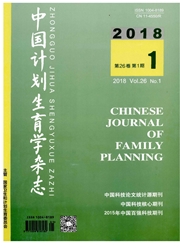

 中文摘要:
中文摘要:
目的:调查广东省佛山市南海区育龄人群中α-和β-地中海贫血(地贫)的基因携带率、基因突变类型及其分布特征。方法:于2009年1月1日~2010年4月30日,在南海区计划生育服务站,连续采集参加孕前优生健康检查的11642例新婚待孕夫妇的外周静脉血。以平均红细胞体积(MCV)〈80fl为地贫筛查血液学阳性指征。对筛查出的1399例阳性样品进一步进行α珠蛋白基因和β珠蛋白基因型分析。结果:育龄人群中地贫基因总携带率为9.91%,其中α-地贫基因携带率为6.45%,β-地贫基因携带率为3.46%,α-和β-地贫基因双重杂合子检出率为0.33%;检出3种缺失型α-地贫基因的构成比依次为77.60%(-SEA)、15.02%(-α3.7)、7.38%(-α4.2);检出β-地贫基因突变类型11种,基因频率排在前5位的依次为CD41-42(-TTCT,38.21%)、IVS-Ⅱ-654(C→T,22.83%)、-28(A→G,10.17%)、CD17(A→T,4.71%)、CD43(G→T,4.71%),占突变基因的91.07%。结论:本研究描述了佛山市南海区育龄人群常见的α-和β-地贫的发生率和较为详细的基因突变谱,为在本地区人群地贫防治提供依据。
 英文摘要:
英文摘要:
Objective:To investigate gene carrier rates,mutation types and distribution characteristics of α-thalassemia and β-thalassemia among the newlyweds at reproductive age in Nanhai district of Foshan City. Methods:Peripheral venous blood samples were collected from 11 642 newlyweds. Less than 80fl of mean corpuscular volume (MCV) was used as the positive indicator for screening thalassemia. A total of 1 399 samples of identified subjects with positive α-thalassemia and β-thalassemia phenotypes were detected by molecular biological technique for further analysis. Results:A total frequency of thalassemia gene was 9.91%,6.45% for α-thalassemia,3.46% for β-thalassemia and 0.33% for β-thalassemia combining deletional α-thalassemia. The three prioritized types of deletional α-thalassemia were as followings:77.60% (--SEA),15.02% (-α3.7)and 7.38%(-α4.2),respectively. Eleven types of β-thalassemia mutation were detected and the five prioritized gene mutations in terms of gene frequency were as followings:CD41-42 (-TTCT)(38.21%),IVS-Ⅱ-654 (C→T)(22.83%),-28(A→G)(10.17%),CD17(A→T)(4.71%)and CD43(G→T)(4.71%),with a total frequency of 91.07%. Conclusion:This study shows incidence and mutation rates of α-thalassemia and β-thalassemia among the newlyweds at reproductive age,which provides a basis for prevention of thalassemia.
 同期刊论文项目
同期刊论文项目
 同项目期刊论文
同项目期刊论文
 期刊信息
期刊信息
